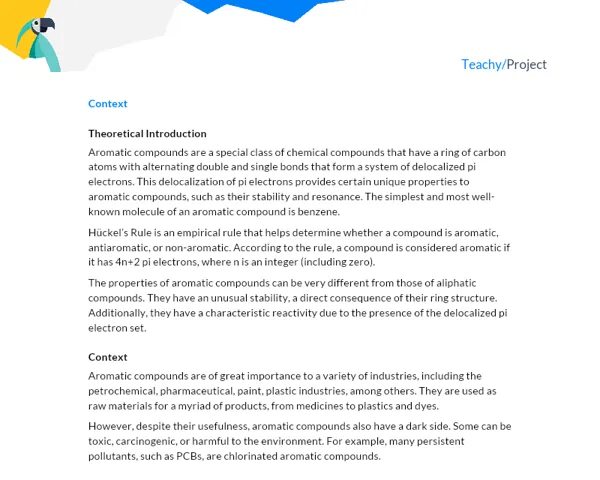Contextualization
Theoretical Introduction
Esters represent a class of organic compounds that present great relevance both in the industry and in everyday chemistry. They are characterized by a functional ester group, R-COO-R', where R and R' are carbon chains that can be the same or different. They can also vary regarding the number of carbons and the type of bonding between them.
Getting to know the ester nomenclature is essential both for their identification and classification. It also provides a solid basis for understanding their properties and chemical reactions. The official ester nomenclature follows the IUPAC (International Union of Pure and Applied Chemistry) rules and is based on the identification of the radicals that bond to the ester group (R-COO-R').
The radical R' is called "prefix" and the radical R is called "suffix". In the ester name, the "prefix" is always followed by the word 'ethanoate', 'propanoate', 'butanoate' and so on, regarding the number of carbon atoms in the radical R. Therefore, the nomenclature is given by adding: Prefix + suffix + 'ate' + 'of' + prefix + 'yl'
Contextualization and its Importance
We can find esters in various products we use in our daily lives, such as in medicines, cosmetics, plastics, among others. For example, ethyl acetate is an ester widely used as a solvent in the pharmaceutical and food industries. In nature, we find esters in the essential oils of plants and fruits, which give them their characteristic aromas.
In a broader context, the ability to correctly name esters is a key competence that is necessary in various chemistry areas, which include research, industry, and education. Besides that, improving the understanding of the rules for naming esters also strengthens general knowledge in organic chemistry, which is a central topic in many science and engineering courses.
Practical Activity
Activity Title: Unveiling Esters: Nomenclature and Applications
Activity Objective:
The activity aims to deepen the knowledge of ester nomenclature. It also stimulates teamwork, debate, research and the ability of oral and written presentation.
Activity Description:
Students will be divided into groups of 3 to 5 members. Each group will receive a list of esters, which they should name according to the IUPAC rules. Besides that, each group will research the physical and chemical properties of these esters and where they are applied in the industry and in daily life.
Required Materials:
Students will need access to Chemistry books or the internet in order to conduct research. The group must prepare a presentation in PowerPoint or similar, in which they will discuss the nomenclature, properties and application of the studied esters.
Step by step:
- Groups of students will receive a list of esters;
- Each group will perform the ester nomenclature from the list according to the IUPAC rules;
- After the naming, each group will conduct a research on where these esters can be found in nature, in the industry or in daily life;
- Each group will create a PowerPoint presentation to present the research results to their classmates;
- The presentations will be performed for the whole class, and there will be a moment for discussion and clarification of any doubts at the end of each presentation.
Project Deliverables:
Each group must deliver a report with the following topics:
- Introduction: in which the group will present the contextualization of the theme, its relevance and application in the real world, as well as the objective of the project.
- Development: in which the group will explain the theory behind the ester nomenclature, indicate the methodology used in the research and finally present and discuss the obtained results.
- Conclusion: where the group will present its conclusions on the importance of understanding the ester nomenclature and its practical application.
- Bibliography: where the group will indicate the sources used to conduct the research.
The report should be prepared in a formal language, respecting the grammar rules and the structure of a scientific report. The text must be clear and objective, and arguments must be supported by evidence and bibliographic references .
The practical activity of the project is estimated to last between 2 to 4 hours per participating student, with a deadline of up to one week after the start of the activity.


